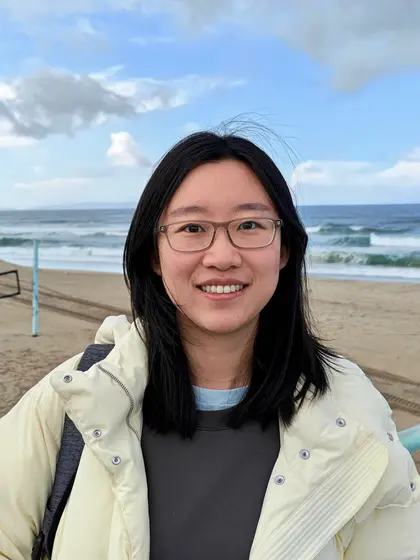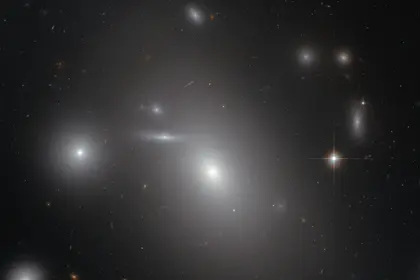
Q: What is your general field of study?
My research focuses on galaxy formation and seeks to understand the physical mechanisms driving the complicated interplay between star formation and mass assembly.. My work centers on a number of key questions. I am interested in how a galaxy’s formation and evolution is influenced by its environment. Likewise, I study what we can learn from the spatial distribution of stellar populations to better understand how massive galaxies grow. For my work I have used observations from the Magellan telescopes at Carnegie’s Las Campanas Observatory, the Very Large Telescope, and the fourth generation of the Sloan Digital Sky Survey. I will keep pursuing these topics using the next-generation observational facilities, including JWST and the Subaru/Prime Focus Spectrograph survey.
Q: Did you always think you would be a scientist?
I watched a documentary film about the Hubble Space Telescope in high school, and I was amazed that astronomers are able to explore space and how HST has changed our understanding of the universe. Ever since then, I wanted to be an astronomer—an observer in particular.
Q: Was your love of science shaped by a particular experience or mentor?
While I was in college, I took a gap year due to family reasons and moved to Pasadena. During that time, I had the opportunity to work at Carnegie Science with Luis Ho and Chien Peng on a project related to HST image decomposition. As part of our work, we revealed faint shell structures produced by a galaxy minor merger event in NGC4889, the brightest cluster galaxy in the Coma cluster. A galaxy minor merger event occurs when a small galaxy falls into a giant galaxy. The remnants left behind from this disruption constitute the shell structure. That project ultimately led to my first research paper. More importantly, however, the whole experience gave me a real-world sense of what scientific research is like. I really enjoyed the work and it’s ultimately what persuaded me to further pursue scientific research.
I have actually been very fortunate that all of my supervisors have been brilliant astronomers, as well as really collaborative, caring advisors. During my graduate program, I was incredibly fortunate to work with Ph.D. advisor Charlie Conroy. In addition to being a highly accomplished researcher, Charlie was a wonderful advisor who put a great deal of thought into how he assigned projects in a way that optimized his students’ learning trajectories and helped us develop as scientists. He was very invested in our success and created a really positive research environment in his group.
Q: Who is your “Science Superhero?”
My science superheroes are Beatrice Tinsley and James Gunn. Beatrice Tinsley is a brilliant, pioneering female astronomer whose research established the foundation for stellar population and galaxy evolution. Her evolutionary synthesis work led to the whole field of combining the models of Spectral Energy Distribution with other observations to learn how galaxies evolve over time. Her work was so creative and innovative, and the concepts described in her research papers still influence the current models.
And I’ve always admired James Gunn. He has made some extremely significant contributions to both theoretical research and the development of groundbreaking astronomical instruments. One of his contributions that I personally benefit from is his leadership in the development of the Sloan Digital Sky Survey (SDSS), which revolutionized the way we map the universe. The SDSS is one of the most ambitious and influential surveys in the field and it has transformed the way we collect astronomical data. He continues to be instrumental in important pioneering projects like the Prime Focus Spectrograph on the Subaru telescope. I think young astronomers like me have all benefited tremendously from his work.
Q: What is the coolest thing you’ve worked on so far in your career?
My research focuses on the formation and evolution of galaxies. To do this research, I use the stellar population synthesis, a technique that determines a galaxy's star formation histories and chemistry. .This technique is like using a galaxy's light to read its history—when its stars were born and how they have changed over billions of years.
I think the coolest thing I have worked on is my most recent project, in which I use stellar population synthesis modeling to learn the initial mass function, or IMF in old quiescent galaxies. The initial mass function represents the mass distribution of stars at the time of a star formation event, which tells us about the variety of stars produced in a star formation. This is very important because, on one hand, it describes the outcome of the star formation process, which is fundamental to our understanding of the physics of star formation and interstellar medium. On the other hand, the initial mass function is a critical starting point, in the modeling of galaxy evolution and cosmology.
Despite its importance, the initial mass function is a challenge to constrain and observe. Even within the Milky Way the star-count work is difficult. One of the big debates in the field is whether the Milky Way’s initial mass function can accurately represent the initial mass function of the entire universe.
For distant galaxies, I’m really excited that we are able to analyze subtle clues hidden in their spectra. Using the stellar population synthesis technique and studying the surface gravity sensitive features, we are able to constrain the initial mass function of elliptical galaxies. We also use dynamic modeling methods, a complementary approach to understanding the initial mass function in elliptical galaxies. So, we are tackling this really challenging problem from multiple angles. With more advanced observations and modeling techniques, we are getting closer to better understanding variation in the initial mass function in the universe.
Right now, at Carnegie, we're leveraging the incredible power of JWST to look back in time and investigate the initial mass function in galaxies from the early universe. I’m really excited that each of our projects is a step closer to answering one the most profound questions of the cosmos.

Q: Do you have a favorite galaxy?
Yes, my favorite galaxy is NGC4889, which I referenced earlier. This galaxy is a textbook example of a supergiant elliptical galaxy, offering us a window into the lives of some of the most massive galaxies in the nearby universe. It is relatively easy to observe and has been very useful to scientists for a long time, particularly in our understanding of galaxy dynamics and evolution. It hosts one of the most massive black holes. This particular galaxy holds a special place in my heart because it was the focus of my very first research project and it played a key role in my Ph.D. thesis.
Q: What do you think is the most exciting research direction happening in your field right now? Looking 10 years ahead, what future development do you think will have the greatest impact on your field?
We have new observational facilities like the JWST telescope. In addition, two extremely large telescopes are under development. Two of them are being developed in the United States -- the 25.4-meter Giant Magellan Telescope is under construction at Carnegie’s Las Campanas Observatory.)
These new instruments will provide us unprecedented resolution to observe the sky. There are also new survey projects in development like the Prime Focus Spectrograph on the Subaru Telescope, and the Dark Energy Spectroscopic Instrument. They can map millions of galaxies—enormous swaths of the universe, allowing us to observe their distribution and how they’re connected. Machine learning is making a major impact on many scientific disciplines, and astronomy is one of them. Because of that, we are seeing a dramatic improvement in the efficiency of computational models in our field.
Q: What are some of the challenges you have encountered in your career so far and how did you address them?
Balancing a career in academia with my personal life can be challenging. My husband is in the same field but lives in Beijing, so having a long-distance relationship is also hard. We’re both astronomers and it’s an extremely competitive field that doesn’t have a lot of research positions, so it’s hard to find academic positions in the same city. We’re working toward fixing that because he is an assistant professor at Tsinghua University, and I’m taking a new role as an assistant Professor at the University of Hong Kong, so we’ll be only a three and a half-hour flight away from each other. We’ll finally be in the same time zone.
Q: What advice would you give to graduate students and others who are just starting their scientific careers?
I was a really shy student and learned how important it is to communicate with people and ask questions. Stay curious and be patient. Academia can be challenging but it can also be a lot of fun. Definitely be prepared to be frustrated at times when doing research, but just keep moving forward and take care of yourself.
Q: Why did you decide to do a postdoctoral position at Carnegie?
First, my supervisor Drew Newman is a brilliant astronomer. I had worked and collaborated with him before when I was at Princeton. He is a P.I. and was looking for a postdoc to work with him on a JWST project focused on a distant galaxy named MRG-0M0138. There are also so many other brilliant scientists at Carnegie with whom I wanted to work. And, of course, Carnegie has amazing observational facilities like the Magellan telescope at Las Campanas that are instrumental to my work.
Q: What has your experience at Carnegie meant to you?
Carnegie is a wonderful institution for astronomers. I especially value the collaborative spirit it fosters. Having the opportunity to work with and learn from so many brilliant astronomers and talented postdocs has been an invaluable experience for me. Carnegie provides opportunities that are hard to find elsewhere. The exceptional observational resources available here allow me to design my observation projects. It's been an incredibly rewarding journey.
